- You are here:
- Home »
- Coaching
Category Archives for Coaching

Pulse Scrimmages Based On Fartlek Training
By Matthew Carroll –
Description: A take on the classic Fartlek Run players participate in a light jog and then must quickly activate their muscles and mindset into playing mode, similar to the interactions they would see on gameday.
Setup:
Players are split into 4 teams with a field size determined by the number of total players. The field is divided in half for 2 small sided fields
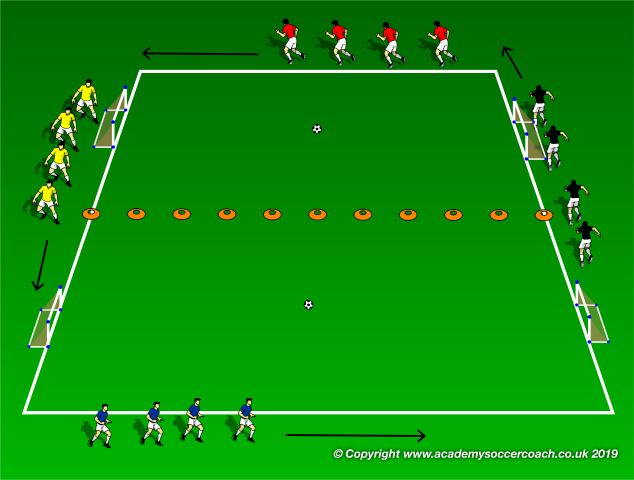
Execution:
The teams all jog around the perimeter of the field. The entire game should last around a total of 40 minutes so players are all jogging then every 5 minutes the coach calls out the teams that will play each other (I.e. 1v4 and 2v3) and those teams must sprint to the fields and play a small sided game for 3 minutes.
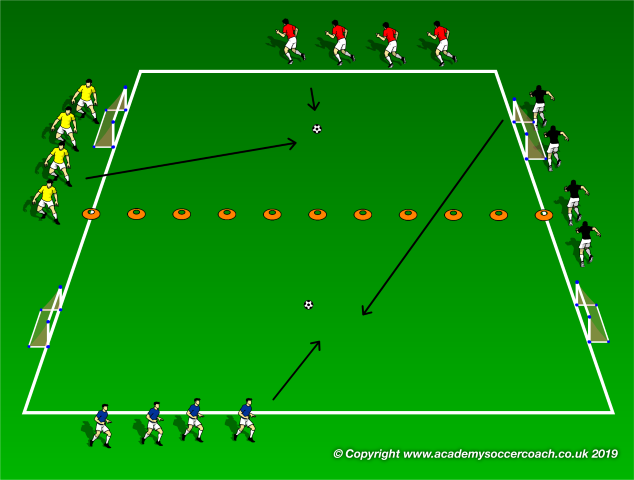
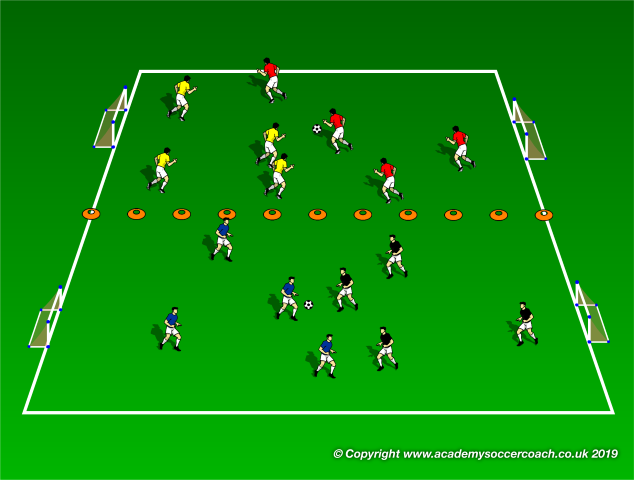
Games starts as soon as the first player is able to reach the ball. The winner of the small sided game gets a one minute juggle break, the losers immediately start the jog around the fields
Variations:
one field can be used with the games being one goal matches with the winner staying on
Games can be played w/ or w/o goalies.
By Matthew Carroll
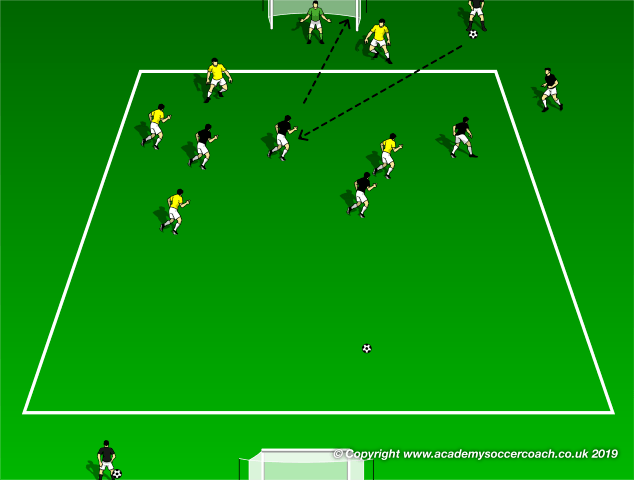
Live Raptor Bomb Game
By Matthew Carroll –
Description:
The diagonal pass from the endline is statistically the most dangerous pass in the game from an attacking standpoint. The Live Raptor Bomb drill attempts to recreate repetition of this scenario in as an organic manner as possible.
Setup:
One 30×30 grid is set up with a 5v5 being played within. At the edge of the far ends of the grids set up an 18 yard box. Two coaches or extra players should then be set up between the 6 and 18 on the end line with balls. Each goal should have a goalie and be designated as teams goal.
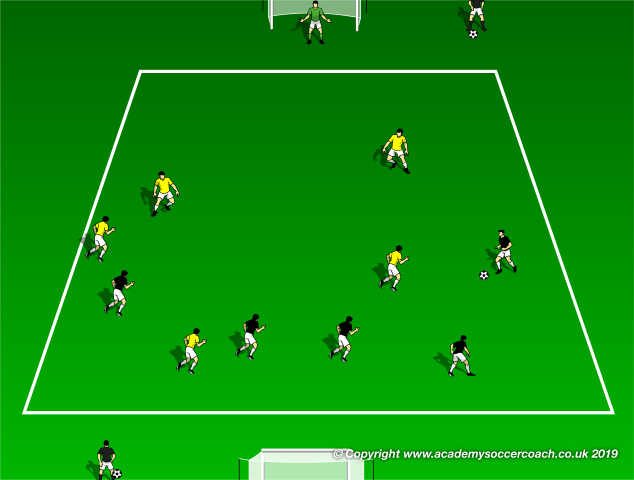
Execution:
Within the grid the two teams set play each other in a game of keep away. When the team in possession completes a designated set of passes they then open up access to go to their oppositions goal. Once they have access the attacking team leaves the ball where it is and runs towards goal, once they reach the 18 the coach/player with the ball on the end line plays a ball diagonally and back for one of the attackers to try and score.
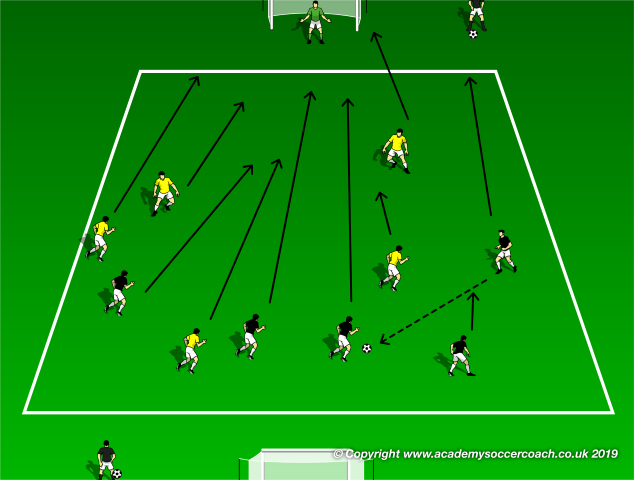

The defending team attempts to stop them. The attack is over once the ball leaves the 18 or a goal is scored. Play then resets inside the 30×30 grid.
Variations:
-Attack can be randomized, with the coach blowing a whistle and the team in possession can then go and attack.
-Defenders can be given targets to pass to to score points on the defensive side
By Matthew Carroll
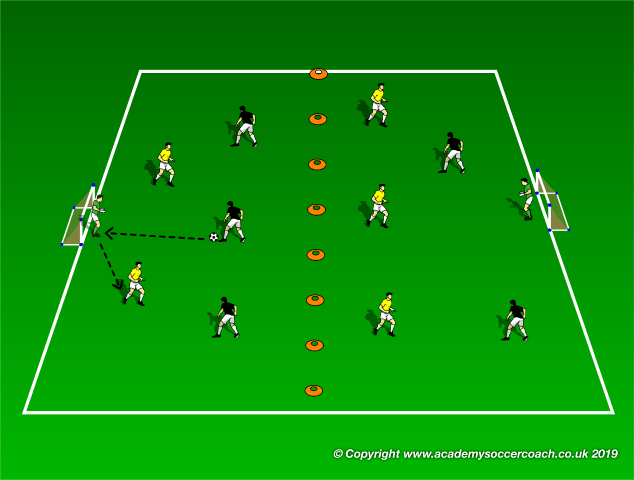
3v2 to 5v5 Transition Game
By Matthew Carroll –
Description:
The purpose of this grid game is to create moments of transition focusing on building from the back and the counter attack. By creating a smaller field and more transition moments the players can more effectively envision and execute lighting fast counters from goalie buildup.
Setup:
Create 2 connected 30×30 grids, The team on the ball starts in the opposition grid facing the opposition goal with three players. The opposition has two defenders facing the team with the ball. The team on the ball leaves two defenders in the opposite grid and and the defending team leaves 3 players with them.
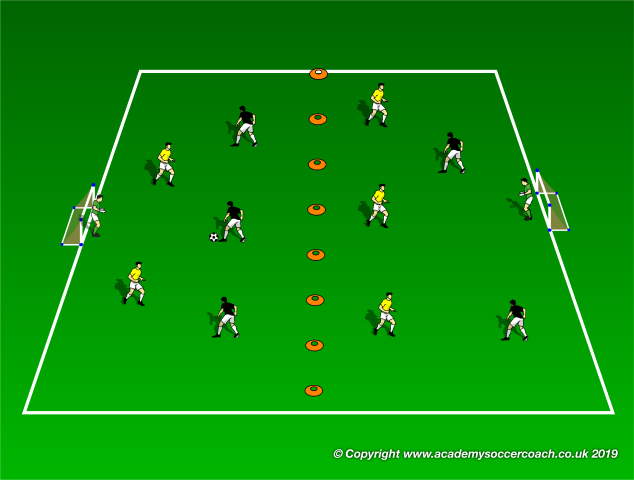
Execution:
The team on the ball attacks the opposition goal in a 3v2. If they score the point the defending team must then build out with the goalkeeper to try to pass to their teammates in the other grid, while the team that just scored will tries to press the opposition and score again.

If the build up team can get the ball past half the three attackers on the opposite side then engage in a 3v2 and try to score.
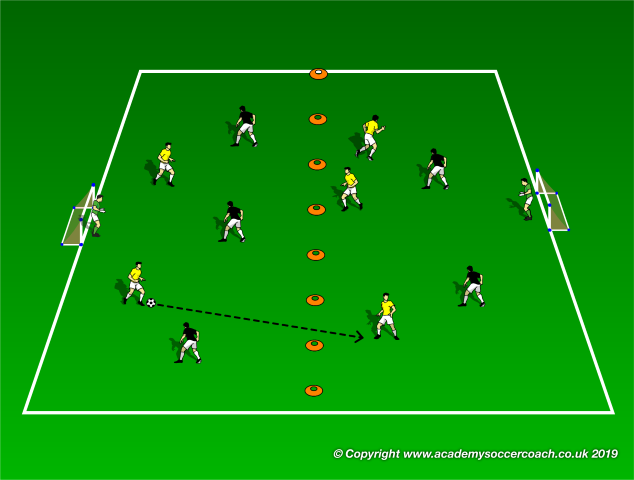
Variations:
To create more 3v2 attacking opportunities the buildup play/press phase can be skipped.
To simulate a 6 transitioning play on the build up phase the build up team can be allowed to have one of their attackers allowed to play between both grids to link the 2 defenders and 2 attackers
By Matthew Carroll
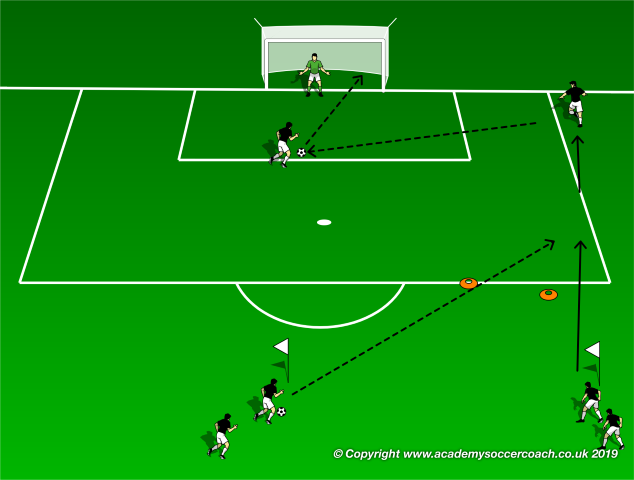
The Most Effective Pass in the Game
By Matthew Carroll –
Description:
The purpose of the Raptor Bomb drill is to recreate the most effective key pass in the game, the pass directed from the edge of the box and backwards into the 18 with high repetition and pace.
Setup:
Set up a gate angled to cut over the corner of the 18, players should start 20ft beyond the 18 with a cone in the middle for one line, and a cone 20 ft away and lined up with the outside of the gate
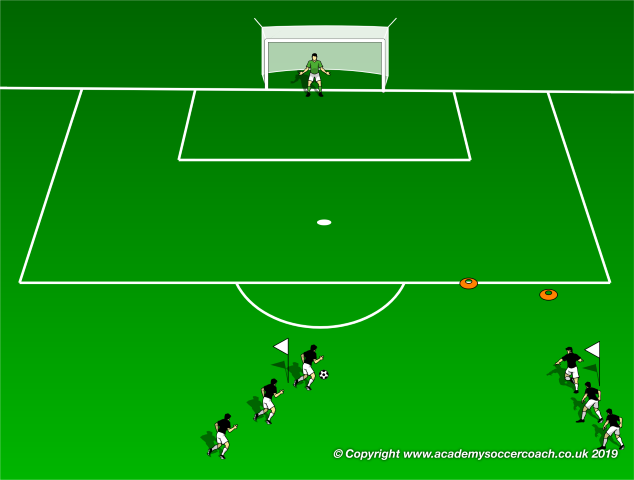
Execution:
Passing line plays it through the gate so that runner is forced to run outside of the gate and receive ball coming towards goal.
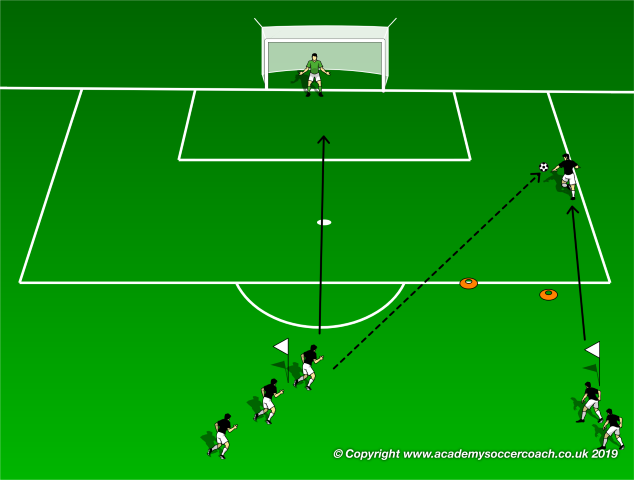
They then cross the ball to the runner who should be behind them. The runner then must one time the ball. After contact is made for the shot the next player passes the ball and the cycle begins again with pace. After a set amount of time players should have scored a set number of goals as directed by the coach.

Variations:
Multiple runners can be used from both sides alternating . Goals and conditions may vary based on ability of players.
By Matthew Carroll

Small-Sided Color Recognition Game
By Matthew Carroll –
Description:
The Color Recognition Game is a good way to get players to start reacting to visual cues, players will be in various angles and therefore will be forced to turn their heads to view the pinny thrown in the air, this naturally teaches players to check their shoulders
Setup:
Create a grid, size determined by number of players. In each corner of the grid place a different colored pinny. Create an age/skill level appropriate obstacle course within the grid. A coach, with a pinny that matches each pinny in the corners, stands in the middle. Players spread themselves out amongst the grid, each with a ball.
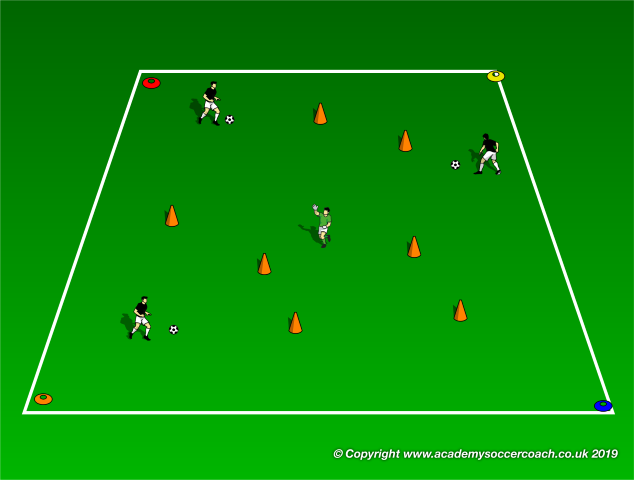
Execution:
Players dribble in the grid with out without a series of obstacles set up by the coach. The coach stands in the middle with the colored pinny and whenever they blow the whistle they throw a pinny in the air. Players must recognize the color of the pinny and then proceed to dribble to the corner with the same colored pinny. Once they stop the ball under their foot on the corner they return to dribbling in the grid and wait for the next whistle
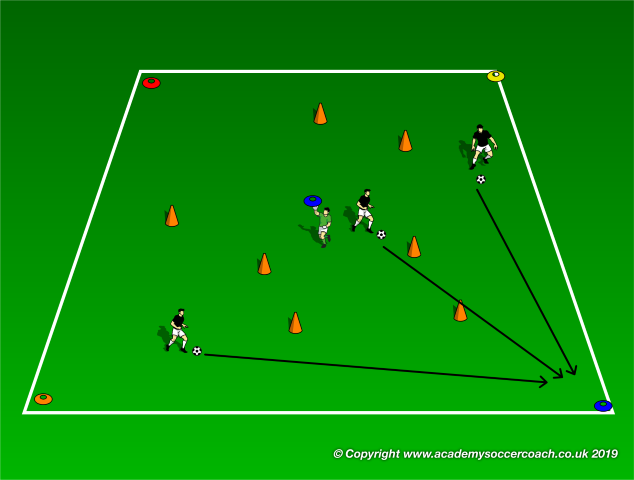
Variations:
The numbers of colors, grids, and players can vary. Defenders can be added to up the difficulty.
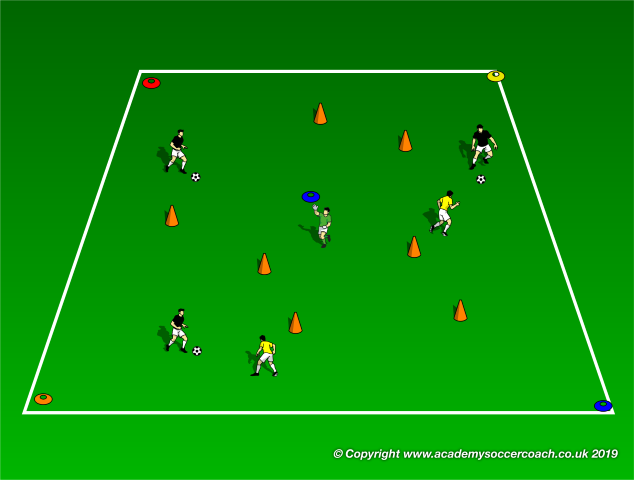
By Matthew Carroll
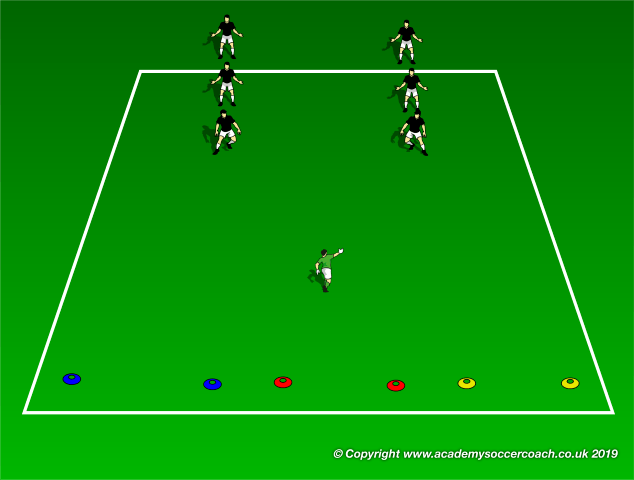
Visual Cues Small-Sided Game
By Matthew Carroll –
Description:
The color game is especially useful for younger players to help them get used to recognizing visual cue that correspond with a physical movement. Even the fastest dribbler on the team will struggle with the game if they cannot adjust to the games visual cues so it can also help those players that rely purely on their speed to add another element to their game.

Setup:
Three grids are created representing red, yellow, and green. Players are put into two line roughly 10 yards from the grids. The player that is “up” in either line has a ball. A coach stands between the grids and players with the placards: a yellow one that says green, a red one that says yellow, and a green one that says red.
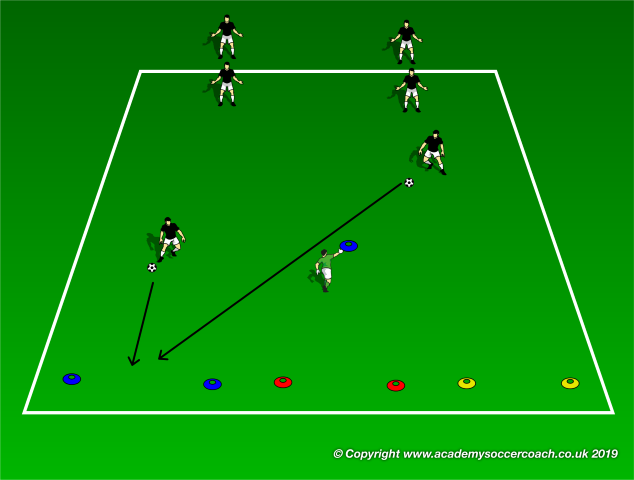
Execution:
The two players that are up start with their balls, the coach holds up one of the placards, the players then identify which grid they need to go to based on what the card says, not the color of the card. The players then race to that grid, who ever makes it there first is the winner and gets to go again, the loser goes to the back of their line.
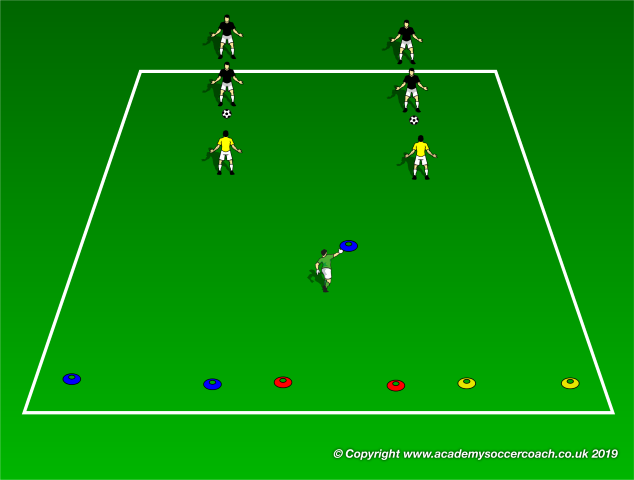
Variations:
The numbers of placards, grids, and players can vary. The players that just went then could become defenders, this would add an element of the importance of the first move to beat a defender to get to space.
By Matthew Carroll
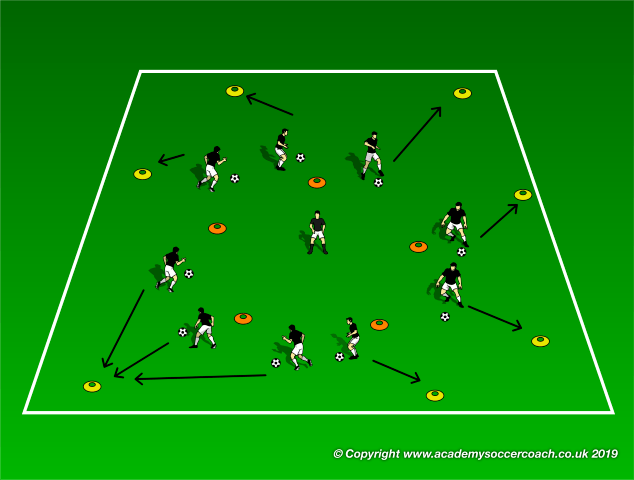
Musical Cones
By Matthew Carroll –
Description:
The Musical Cones Activity is a variation of the children’s game musical chairs. It is a fun warm up activity that will get players focusing on their control on the dribble, as well as their balance and ability to stop the ball. Recommended for younger age groups but can be adapted to older groups as well.
Setup:
The coach is placed in the middle with players dribbling in a circle around him. There is a ring of cones around him. There should be at least one less cone than the number of players. Width of circle and distribution of the cones should be dependent on the size of the group and ability of the players.
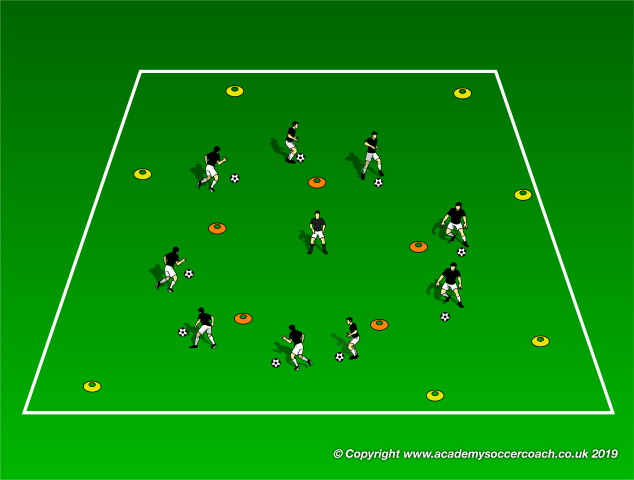
Execution:
The coach plays music/claps/makes noise while the players dribble around him. When the noise stops players must dribble quickly to a one of the cones and stop the ball on one foot, with the other foot on the cone.

The loser needs to do a dance, and then the game resets.
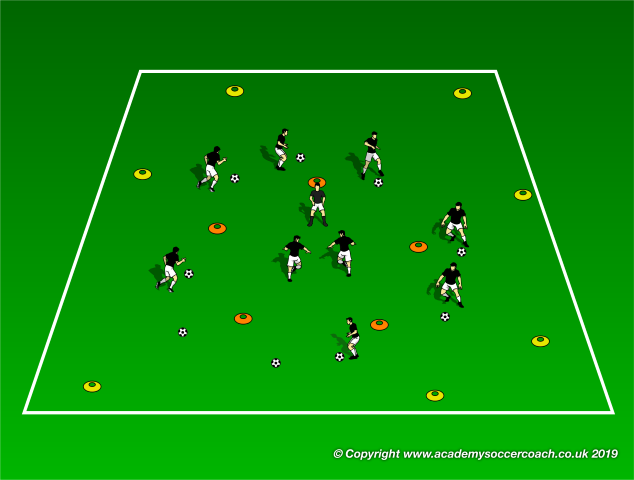
Variations:
The cones can be spread out or in a circle. Players can dribble freely or be in a circle around the coach . The player that loses in each game can be eliminated and given a specific task such as juggling with another coach or for older groups some type of conditioning.
By Matthew Carroll
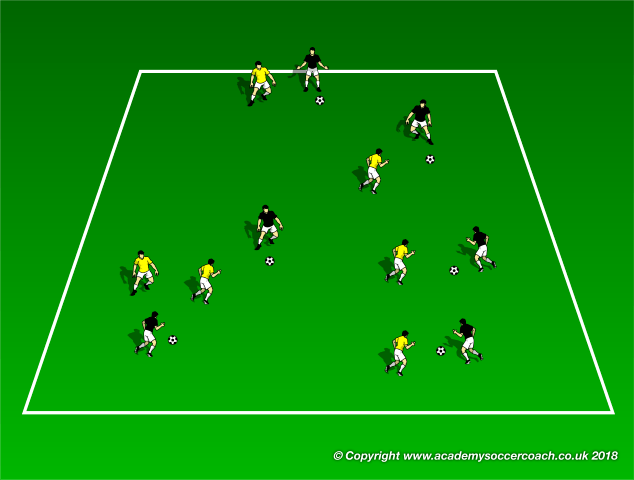
No Elimination Knockout
By Matthew Carroll –
Description: No Elimination Knockout is a game that creates systematized chaos in which the structure of the game is constantly changing from a individual game into a team orientated one. The defensive side works mainly on pressing and denying space to their opponents
Setup:A grid is created in which one team is on “offense”, each player has a ball. The other team is the defending team.

Execution: The defending team attempts to knock the opponent’s balls out of the grid. If a player’s ball is knocked out of the grid they then become an outlet player for their team, until ultimately it becomes a game of keep away with one ball.
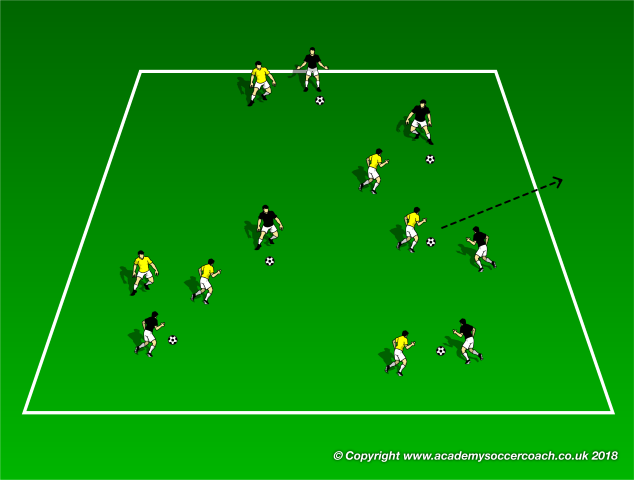
The session is timed. The team that can knock out all of the opponents balls in the fastest time wins.
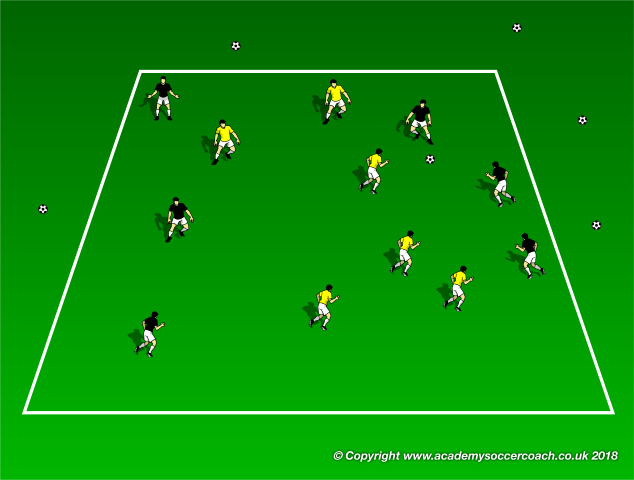
Variations: Grid size, number of players, how many balls are involved are all variables that can be altered.
By Matthew Carroll
